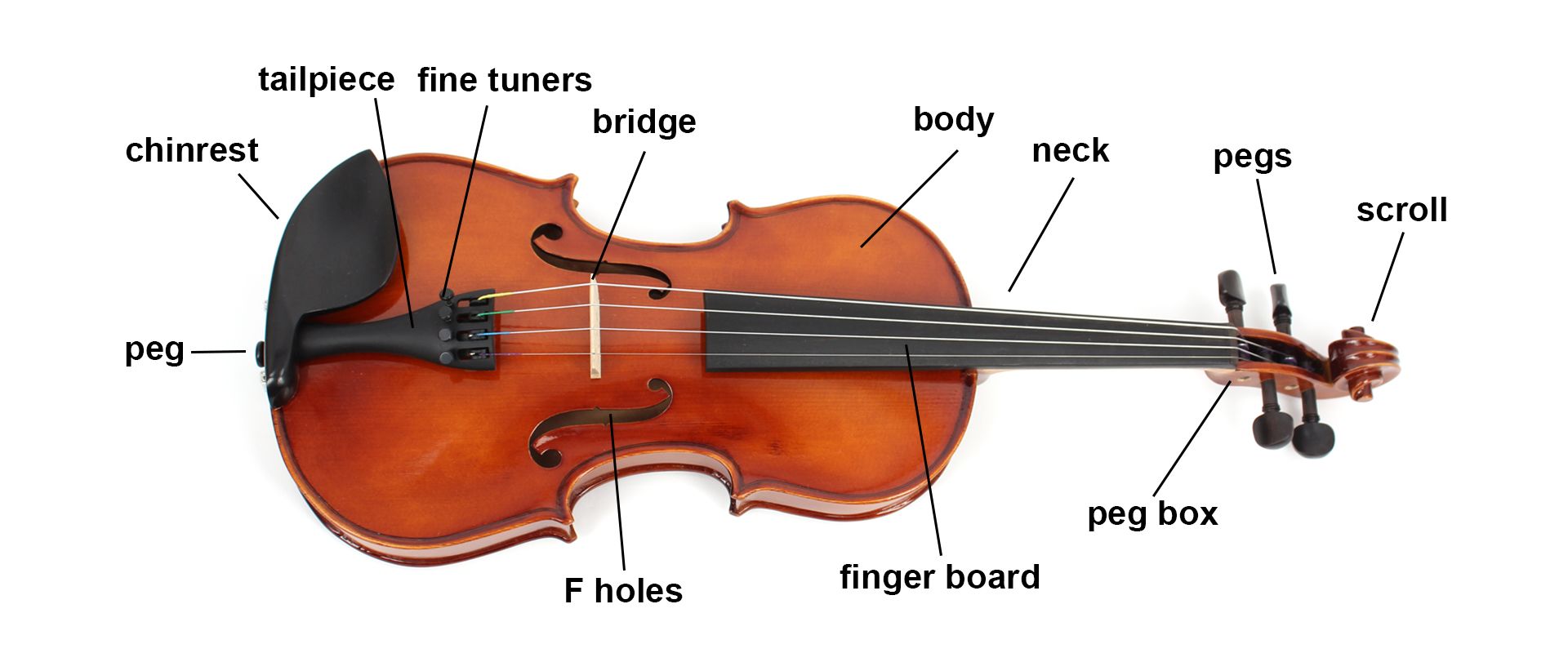Understanding the Parts of a Stringed Instrument

It is important to know the names of the main parts of a stringed instrument, especially when you are choosing one to buy. You will know what the description of an instrument is talking about and can make a better decision. Here we show you the main parts. There are other names describing particular areas of the instrument, like "upper bout" but these are not important just now. Let's work around the instrument explaining the parts to you.
-
Peg - a small tapered wooden peg pushed into a hole at the bottom of the instrument to hold the tailpiece in place. Often made of ebony (wood).
-
Chinrest - it is exactly as the name suggests - somewhere to rest your chin when playing. Not found, of course, on cellos or double basses.
-
Tailpiece - the component that holds the strings. Sometimes ebony or a synthetic material. It needs to be tough as there is a lot of pressure from the strings.
-
Fine tuners - some instruments have only one, others have up to four. It is a small screw-type mechanism allowing you to finely tune the string.
-
Bridge - a thin piece of wood specially shaped over which the strings sit. The correct shape and quality of wood are all-important for playability and good tone.
-
Body - self-evident really, the body of the instrument. Most stringed instruments have a top made of spruce wood while the sides and back are usually flame maple wood. (Flame is when you see stripe patterns in the wood - they look a bit like flames.)
-
Neck - a shaped piece of wood. often maple, that holds the fingerboard and peg-box. It is glued into the body of the instrument.
-
Pegs - these are tapered pieces of wood, often ebony or another suitable strong wood that are pushed into the peg-box. The end of the string is wound around the peg which is then turned slightly to tune the string. On a double bass, a mechanical tuner with a gear is used as the strings are so big and heavy.
-
Scroll - the fancy carved piece at the top of your instrument.
-
Peg box - the wooden piece that the pegs are pushed into. A well made peg box is important so that the pegs fit well and do not slip when pushed in tightly. A poor quality peg box and pegs usually results in the instrument constantly going out of tune.
-
Fingerboard - usually ebony on a quality instrument, it is glued onto the neck. It is where your fingers press down on the strings to obtain the right notes for the music. Cheap instruments often have cheap wood painted black and are horrible to play on.
-
F-holes - the holes in the body to let the sound out! Well sort of. We will let you guess why they are called F holes.
-
Endpin - not shown in the picture, these are found on cellos and double basses. It is a telescopic steel rod that extends out from the bottom of the instrument, used when you play it. It allows the instrument to be raised from the floor.
So what is important out of all that when choosing a stringed instrument? Two things: the quality of the components and the quality of the build. We know there are violin outfits on the internet under €100 and we have looked at them. They get this price by using the very cheapest woods and by building them at super high speed with no attention to detail. The result is an instrument that is horrible to play and sounds awful, a real disadvantage for a beginner, for anyone actually. They hope that you see a shiny instrument in a case and go for the super cheap price. These aren't real violins, they are just toys.
At Schroetter we use good quality components and ensure that each instrument is built with care and is quality checked all the way through the process. The end result is quality instruments, robust, looking good, sounding good and easy to play. They are also very affordable. They are especially suitable for beginners, rental instruments and music schools.
